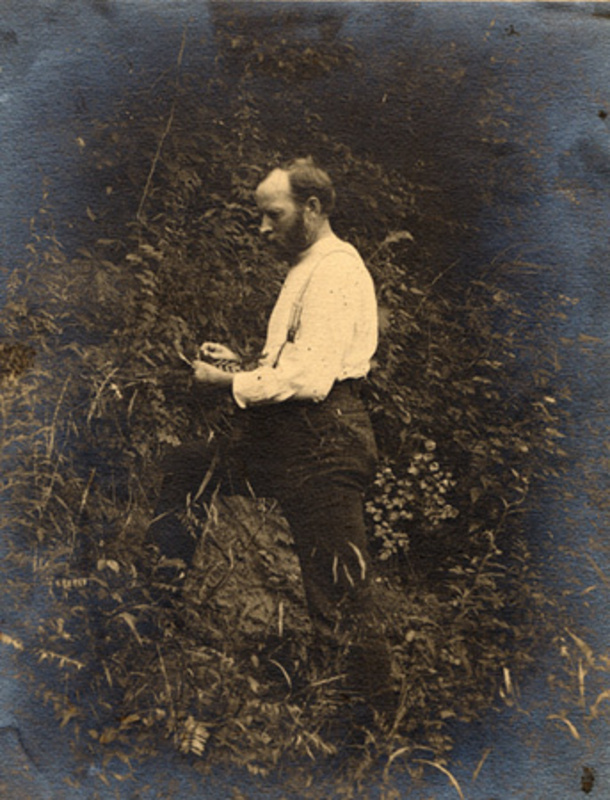Louis H. Pammel Item Info

Louis H. Pammel was born in LaCrosse, Wisconsin in 1862. He graduated from the University of Wisconsin, being the first student to receive a Bachelor of Agriculture degree (1885) from that institution. He graduated with honors for his research of parasitic fungi, including downey mildew of millet. Pammel also received his M. S. (1889) in agriculture from the University of Wisconsin and his Ph. D. (1898) from Washington University. He obtained training under such distinguished professors as Dr. William Trelease, Professor in the Shaw School of Botany at Washington University; Dr. E. A. Birge, Professor of Zoology and a President of the University of Wisconsin; Dr. C. R. Van Hise, Professor of Chemistry and Minerology, also a University of Wisconsin President (1903-1918).
After graduating from the University of Wisconsin, L. H. Pammel became an assistant (1885) to Dr. W. G. Farlow of Harvard University, who was in charge of cryptogamic botany. Later, he became an assistant (1885-1887) in botany at the Shaw School of Botany, Washington University. For two summers, he investigated the cotton root rot in Texas (1888 and 1889).
In February 1889, Pammel came to Iowa State College (University) as Professor of Botany (1889-1929), a position made vacant by the resignation of Dr. Byron Halsted (1884-1888). In addition to teaching botany, he taught courses in Landscape Architecture (1889-1890). Pammel was also the Iowa State College Experiment Station Botanist (1889-1922). During Pammel’s tenure, Iowa State became the first school in the United States to offer bacteriology courses to general students.
Pammel was also a well liked and respected by his students, many of which considered him a great influence in their lives. Among these students was George Washington Carver. In 1891, Carver became the first African American to enroll at Iowa State College of Agriculture and Mechanic Arts (Iowa State University). Pammel encouraged him to stay at Iowa State as a graduate student after he completed his bachelor’s degree (1894). Over the next two years, as assistant botanist for the College Experiment Station, Carver quickly developed scientific skills in plant pathology and mycology, the branch of botany that deals with fungi. He published several articles on his work and gained national respect. Carver completed his master’s degree (1896) and was invited by Booker T. Washington to join the faculty of Alabama’s Tuskegee Institute. Pammel and Carver remained in close contact after Carver moved to Alabama.
Pammel conducted research in plant pathology and in weeds, which resulted in numerous publications, including A Manual of Poisonous Plants (1910), Weeds of the Farm and Garden (1911), and The Weed Flora of Iowa (1913, 1926). Other research activities included the anatomy of seeds and plants of the legume family. In systematic botany, he was interested in the trees and other flora of the country, and he made extensive collections of plants, which he gave to the college. For the United States Forest Service, he made a study of grazing conditions in the Uintah Mountains, and did work on grasses of plains region for the U. S. Department of Agriculture. Many honors were conferred upon Dr. Pammel.
Pammel was a member of numerous professional and honor societies, including the Botanical Society of America, the Ecological Society of America, the American Society of Bacteriology, the St. Louis Academy of Science, the Biological Society of Washington and the Sierra Club. He was twice elected President of the Iowa Academy of Science; was vice president of Section G. Botany, of the American Association for the Advancement of Science (AAAS), and fellow of the AAAS. Pammel was a member of international societies such as Deutsche Bot. Gesellschaft, and the British Ecological Society. He also served as local president of Sigma Xi and was for many years national secretary of Phi Kappa Phi, as well as national president. In 1924, he was president of the National Association of Cosmopolitan Clubs and at one time was secretary of Gamma Sigma Delta. He was active in the creation of Iowa’s state park law and served as the first president of the Iowa State Board of Conservation.
Pammel married Augusta Emmel of Chicago, Illinois in 1887 and they had six children, five daughters and one son. He died in 1931 on a transcontinental train traveling through Nevada.
Resources available online
Louis H. Pammel Papers
RS 13/5/13 University Archives, Iowa State University Library
Ada Hayden Herbarium History
Louis H. Pammel was instrumental in the creation of Iowa’s state park law and served as the first president of the Iowa State Board of Conservation.
- Title:
- Louis H. Pammel
- Source Identifier:
- pammel-louis-gatheing-plant
- Preferred Citation:
- "Louis H. Pammel", 150 Years, Iowa State University Library
- Reference Link:
- https://digital.lib.iastate.edu/exhibits/150years/items/150years0087.html